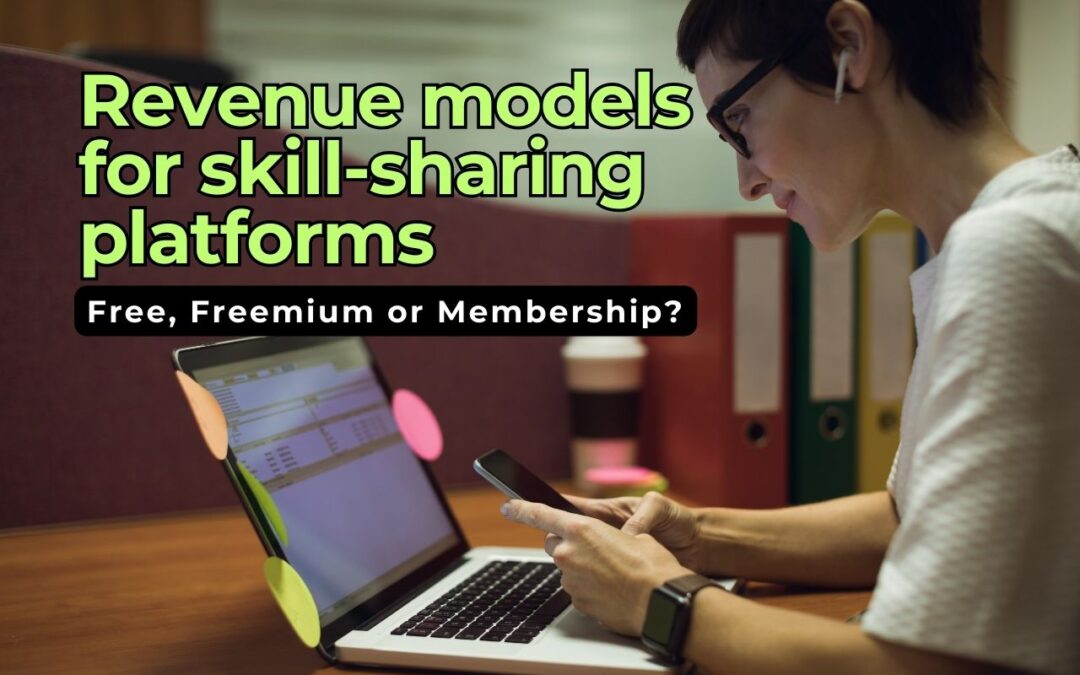In the digital economy era, revenue models for skill-sharing platforms are not only convenient but they are also revolutionizing the way individuals learn, teach and make money off their skills. From virtual coding boot camps to tutorials on baking, platforms have become highly vibrant communities. But every thriving platform has a highly thought-out revenue model for skill-sharing platforms.
Regardless of whether you are a founder who is looking to start their own marketplace or an investor making the decision on whether it is worth investing in, be sure to understand the advantages and disadvantages of different revenue models. Should you choose free, freemium or membership-based models? Let’s analyze.
Why the Revenue Model for Skill-Sharing Platforms Matters
A revenue strategy for skill-sharing platforms is not merely a method of making money, it’s the template that defines user experience, long-term commitment, and sustainability.
An effective model can:
- Align your mission and audience.
- Optimize user retention while remaining profitable.
- Evolve with the shifting marketplace and trends while not losing your follower base.
Consider it the money DNA of your platform; set once, it dictates everything from marketing efforts to feature engineering.
Option 1: The Free Model
There’s a free model where users get access to most or all content at no cost. Such a model is typically complemented by other monetization strategies, such as ads or sponsorships.
Benefits:
- Broader Reach: With no paywall, you’re likely to get a big user base fast.
- Potential for Viral Growth: Free access will make users share and use word of mouth.
- Lower Resistance from Users: Users are likely to experiment with a free product.
Limitations:
- You require a huge audience for ad revenue to be significant.
- Risk that with everything being free then it loses its perceived value.
- Dependence on advertisers can divert attention away from user needs.
Free-based revenue model for skill-sharing platforms works best for creators who want to establish a large community first before heavily monetizing, e.g., early-day YouTube or Coursera offerings.
Option 2: The Freemium Model
The freemium model is the most successful method in the e-learning and digital content business. It provides free basic features, while premium tools, special classes or certifications cost money.
Benefits:
- Distributed Access: Users test your service risk-free before financially committing.
- Increased Conversion Potential: Premium features seduce upgrades.
- Revenue Flexibility: You can test several premium tiers.
Drawbacks:
- Free tier should be enticing enough to attract users without dominating paid options.
- Ongoing need to refresh premium content to be worth the money.
For most people in business, the freemium business model for ability-share platforms strikes the right balance, if you’re going to create other specialty courses, mentorship licenses or VIP access to your community.
Option 3: Membership or Subscription Model
With the subscription model, the user pays a set subscription fee either monthly, quarterly or yearly for access to everything the site has to offer. This model gives consistent cash flow and loyal customers.
Benefits:
- Constant Income Stream: Subscriptions give fixed income.
- Community Building: Paying members tend to be more invested and loyal.
- Growth on a Scalable Basis: Simple to project revenue for reinvestment.
Drawbacks:
- More difficult to persuade new users to pay without trial access.
- Involves a constant stream of current content.
If you are looking for a sustainable model, subscription models can be useful for skills-sharing activities, especially if they are high quality, relevant and offer niche-related content.
Hybrid Models: Why Choose?
A hybrid revenue model for skill-sharing platforms lets you target both casual learners and committed professionals. There are some successful platforms that blend all of these approaches by:
- Providing a free beginner lesson library.
- Providing a freemium version with paid upgrades in exchange for certificates.
- Providing a member tier that allows unlimited access to mentorship and live events.
A hybrid revenue model allows skill-sharing sites to target a wide audience; they can target people learning for opportunistic attempts and people wanting to engage with the skill professionally.
Keep In Mind Before You Choose Your Model
Choosing the right revenue model for skill-sharing platforms means aligning your goals, audience and content value. You will need to note:
- Your Target Audience – Are they hobbyists, professionals or students?
- Content Value – Is your content very niche and not available anywhere else?
- The market in relation to competitors – How are similar platforms monetizing their content?
- Your platform goals – Are you focused on rapidly growing, sustainably getting paid or establishing a brand?
- Scaling – Can your design scale with your user population without crashing infrastructure?
Maximizing Profit Independent of Model
Regardless of the revenue models for skill-sharing platforms you adopt, profitability is all about execution. Examples of effective strategies include:
- Tailored Suggestions: Suggest courses based on what each user does to drive engagement.
- Limited-Time Promotions: Get the user to sign-up via a seasonal offer or promotional activity.
- Fragmate Gamification: Keep them engaged through incentivized progress rewarded with badges or points etc.
- Partnerships: Connect with industry leaders to capture niche audiences.
Use Cases: Real World Applications
- Skillshare- Implemented a membership model and provided unlimited access to every course while taking a monthly subscription fee.
- Udemy- Mainly a freemium site where courses are each charged separately but regular sales make them affordable.
- Khan Academy- A free model in its entirety, fundraised through donations and grants, geared for global educational reach.
These examples illustrate that there truly isn’t an ingredient for skill-sharing site business models, it is just about finding the correct fit with your vision and user.
Conclusions:
The e-learning market is continuing to grow at double-digit rates, driven by trends in remote work and upskilling and improved comfort with online education. Choosing the correct revenue model for skill-sharing platforms today is not only going to impact when and how they become profitable but also determines your company’s adaptability to changes in technology and user behavior moving forward.
The nice thing about this space is it’s adaptable, you can start at a single model, try it out and adjust based on your learnings about your users.When you take data driven action (not gut instinct), your platform will carve out its niche in the market. So free, freemium or membership, which revenue models do you think the skill-sharing platforms will dominate within the years ahead?













